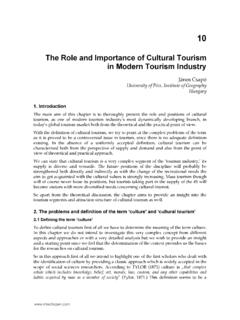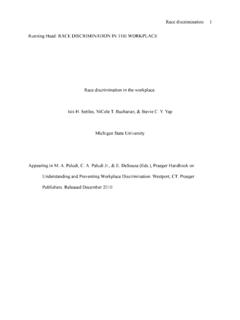Transcription of Chapter Preview - SAGE Publications
1 1 Defining Interdisciplinary studies _____ Chapter Preview For over a century, universities and colleges throughout the world at all levels have relied on academic disciplines as platforms for imparting knowledge and generating new knowledge. Today, interdisciplinary learning at all levels is far more common as there is growing recognition that it is needed to answer com- plex questions, solve complex problems, and gain coherent understanding of complex issues that are increasingly beyond the ability of any single discipline to address comprehensively or resolve adequately. As Carole L. Palmer (2001).
2 Writes, The real-world research problems that scientists address rarely arise within orderly disciplinary categories, and neither do their solutions (p. vii). This Chapter (1) explains the meaning of interdisciplinary studies , (2) presents a definition of interdisciplinary studies , (3) explains what inter- disciplinary studies is not, (4) discusses how the term interdisciplinarity is variably used today, and (5) identifies metaphors commonly associated with interdisciplinary work. _____ The Meaning of Interdisciplinary studies The meaning of interdisciplinary studies or interdisciplinarity continues to be contested by its practitioners and critics.
3 But emerging from this debate are key concepts around which consensus is developing and which inform the integrated definition of interdisciplinary studies used in this book. The follow- ing discussion unpacks the meaning of these terms and, in doing so, introduces some of the theory undergirding this diverse and growing academic field. Two Conceptions of Interdisciplinary studies A primary focus of the ongoing debate over the meaning of interdisciplinary studies or interdisciplinarity concerns integration. Integration literally means to make whole. In the context of interdisciplinarity, integration is a process 3.
4 4 PART I ABOUT INTERDISCIPLINARY studies . by which ideas, data and information, methods, tools, concepts, and/or theo- ries from two or more disciplines are synthesized, connected, or blended. Generalist interdisciplinarians understand interdisciplinarity loosely to mean any form of dialog or interaction between two or more disciplines . while minimizing, obscuring, or rejecting altogether the role of integration (Moran, 2010, p. 14).1. Integrationist interdisciplinarians, on the other hand, believe that integration should be the goal of interdisciplinary work because integration addresses the challenge of complexity.
5 Integrationists point to a growing body of literature that connects integration with interdisciplinary education and research , and are concerned with developing a distinctively interdisciplinary theory-based research process and with describing how it operates (Newell, 2007a, p. 245;. Vess & Linkon, 2002, p. 89). They advocate reducing the semantic evasiveness surrounding the term interdisciplinarity and point to research in cognitive psy- chology that shows that integration is both natural and achievable. This book is aligned with the integrationist understanding of interdisciplinarity.
6 The Discipline Part of Interdisciplinary studies Inside the academy, the term discipline refers to a particular branch of learn- ing or body of knowledge such as physics, psychology, or history (Moran, 2010, p. 2). According to the American Association for Higher Education and Accreditation (AAHEA), Disciplines have contrasting substance and syntax .. ways of organizing themselves and of defining rules for making arguments and claims that others will warrant. They have different ways of talking about themselves and about the problems, topics, and issues that constitute their subject matters.
7 (Schulman, 2002, pp. vi vii). Mary Taylor Huber and Sherwyn P. Morreale (2002) add that each disci- pline has its own intellectual history, agreements, and disputes about subject matter and methods and its own community of scholars interested in teach- ing and learning in that field (p. 2). Disciplines are also distinguished from one another by several factors. These include the questions disciplines ask about the world, their perspective or worldview, the set of assumptions they employ, and the methods they use to build up a body of knowledge (facts, concepts, theo- ries) around a certain subject matter (Newell & Green, 1982, p.)
8 25). Academic disciplines are scholarly communities that specify which phenom- ena to study, advance certain central concepts and organizing theories, embrace certain methods of investigation, provide forums for sharing research and insights, and offer career paths for scholars. It is through their power over careers that disciplines are able to maintain these strong preferences. Each dis- cipline has its own defining elements phenomena, assumptions, epistemology, concepts, theories, and methods that distinguish it from other disciplines. Chapter 1 Defining Interdisciplinary studies 5. These are the subject of Chapter 4.
9 All of these characteristics are interrelated and are subsumed within an overall disciplinary perspective. History is an example of a discipline because it meets all of the above criteria. Its knowledge domain consists of an enormous body of facts (every- thing that has been recorded in human history). It studies an equally enormous number of concepts or ideas (colonialism, racism, freedom, and democracy). It generates theories about why things turned out the way they did ( , the great man theory argues that the American Civil War lasted so long and was so bloody because President Abraham Lincoln decided to issue the Emancipation Proclamation in 1862), though many historians strive to be atheoretical.
10 And it uses a research method that involves close reading and critical analysis of primary sources ( , letters, diaries, official documents). and secondary sources ( , books and articles on a topic) to present a coher- ent picture of past events or persons within a particular time and place. Categories of Traditional Disciplines There are three broad categories of traditional disciplines2 (see Table in Chapter 4): The natural sciences tell us what the world is made of, describe how what it is made of is structured into a complex network of interdependent systems, and explain the behavior of a given localized system.














